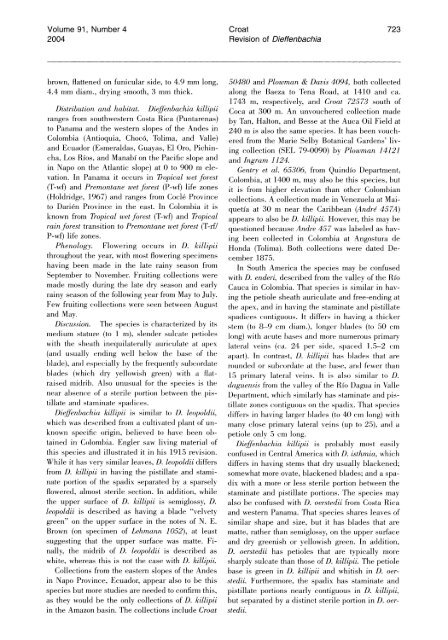l - CNCFlora
l - CNCFlora
l - CNCFlora
You also want an ePaper? Increase the reach of your titles
YUMPU automatically turns print PDFs into web optimized ePapers that Google loves.
Volume 91, Number 4<br />
2004<br />
Croat<br />
Revision of Dieffenbachia<br />
, . .<br />
brown, flattened on funicular side, to 4.9 mm long, 50480 and Plowman & Davis 4094, both collected<br />
4.4 mm diam., drying smooth, 3 mm thick. along the Baeza to Tena Road, at 1410 and ca.<br />
1743 m, respectively, and Croat 72573 south of<br />
Distribution and habitat. Dieffenbachia killipii Coca at 300 m. An unvouchered collection made<br />
ranges from southwestern Costa Rica (Puntarenas) by Tan, Halton, and Besse at the Auca Oil Field at<br />
to Panama and the western slopes of the Andes in 240 m is also the same species. It has been vouch-<br />
Colombia (Antioquia, Choco, Tolima, and Valle) ered from the Marie Selby Botanical Gardens' livand<br />
Ecuador (Esmeraldas, Guayas, E1 Oro, Pichin- ing collection (SEL 79-0090) by Plowman 14121<br />
cha, Los Rios, and Manabi on the Pacific slope and and Ingram 1124.<br />
in Napo on the Atlantic slope) at 0 to 900 m ele- Gentry et al. 65306, from Quindio Department,<br />
vation. In Panama it occurs in Tropical wet forest Colombia, at 1400 m, may also be this species, but<br />
(T-wf) and Premontane wet forest (P-wf) life zones it is from higher elevation than other Colombian<br />
(Holdridge, 1967) and ranges from Cocle Province collections. A collection made in Venezuela at Maito<br />
Darien Province in the east. In Colombia it is quetia at 30 m near the Caribbean (Andre' 457A)<br />
known from Tropical wet forest (T-wf) and Tropical appears to also be D. killipii. However, this may be<br />
rain forest transition to Premontane wet forest (T-rf/ questioned because Andre 457 was labeled as hav-<br />
P-wf) life zones.<br />
ing been collected in Colombia at Angostura de<br />
Phenology. F8lowering occurs in D. kill ipii Honda (Tolima). Both collections were dated Dethroughout<br />
the year, with most flowering specimens cember 1875.<br />
having been made in the late rainy season from In South America the species may be confused<br />
September to November. Fruiting collections were with D. enderi, described from the valley of the Rfo<br />
made mostly during the late dry season and early Cauca in Colombia. That species is similar in havrainy<br />
season of the following year from May to July. ing the petiole sheath auriculate and free-ending at<br />
Few fruiting collections were Kseen between AuguKst the apex, and in having the staminate and pistillate<br />
and May.<br />
spadives (ontiguous. Tt diffels in having a thicker<br />
Di.scu.s.sion. The specieKs is chara(terized by its stem (to 8-9 cm diam.), longer blades (to 50 cm<br />
medium stature (to 1 m), slen(ler sulcate petioles long) with ae ute hases and more numerous primary<br />
with the Ksheath inequilaterally auli(ulate at apex lateral veins (( a. 24 lel side, spae e(-l 1.5-2 ( m<br />
(an(l uxually ending well helow the l)ase of the apalt). Tn (ontraKst, L). killi/)ii has hla(lex that are<br />
l)la(le) an(l espe(ially ly the flequelltly Ksul)cor(late roundeel or sul)( or(3ate at the hase, ;an(l fewer than<br />
bladeKs (whie h dry yellowish green) with a flat- 15 primary lateral veins. It is also similar to D.<br />
raised mi(lrib. Also unuKsual for the sl)e(ies is the elelguellsi.s from the valley of the Rio Dagua in Valle<br />
near absenfe of a Ksterile portioll between the pis- Department, whie h similarly has staminate and l)istillate<br />
and staminate spadie es.<br />
tillate zones ( ontiguous on the spa(lix. That spee ies<br />
Dieffenb(lchiel killipii is similar to L). Ieo)oldii, eliffers in having larger hlades (to 40 c m long) with<br />
whieh waKs descIibed from a cultivate(l plant of un- many elose primary lateral veins (up to 25), an(l a<br />
known specific origin, believed to have been ob- petiole only 5 cm long.<br />
tained in Colombia. Engler saw living material of Dieffenbachia killipii is probably most easily<br />
this species and illustrated it in his 1915 revision. confused in Central America with D. isthmia, which<br />
While it has very similar leaves, D. Ieopoldii differs differs in having stems that dry usually blackened;<br />
from D. killipii in having the pistillate and stami- somewhat more ovate, blackened blades; and a spanate<br />
portion of the spadix separated by a sparsely dix with a more or less sterile portion between the<br />
flowered, almost sterile section. In addition, while staminate and pistillate portions. The species may<br />
the upper surface of D. killipii is semiglossy, D. also be confused with D. oerstedii from Costa Rica<br />
Ieopoldii is described as having a blade "velvety and western Panama. That species shares leaves of<br />
green" on the upper surface in the notes of N. E.<br />
Brown (on specimen of Lehmann 1052), at least<br />
similar shape and size, but it has blades that are<br />
matte, rather than semiglossy, on the upper surface<br />
suggesting that the upper surface was matte. Fi- and dry greenish or yellowish green. In addition,<br />
nally, the midrib of D. Ieopoldii is described as D. oerstedii has petioles that are typically more<br />
white, whereas this is not the case with D. killipii. sharply sulcate than those of D. killipii. The petiole<br />
Collections from the eastern slopes of the Andes base is green in D. killipii and whitish in D. oerin<br />
Napo Province, Ecuador, appear also to be this stedii. Furthermore, the spadix has staminate and<br />
species but more studies are needed to confirm this, pistillate portions nearly contiguous in D. killipii,<br />
as they would be the only collections of D. killipii but separated by a distinct sterile portion in D. oerin<br />
the Amazon basin. The collections include Croat stedll.<br />
723

















